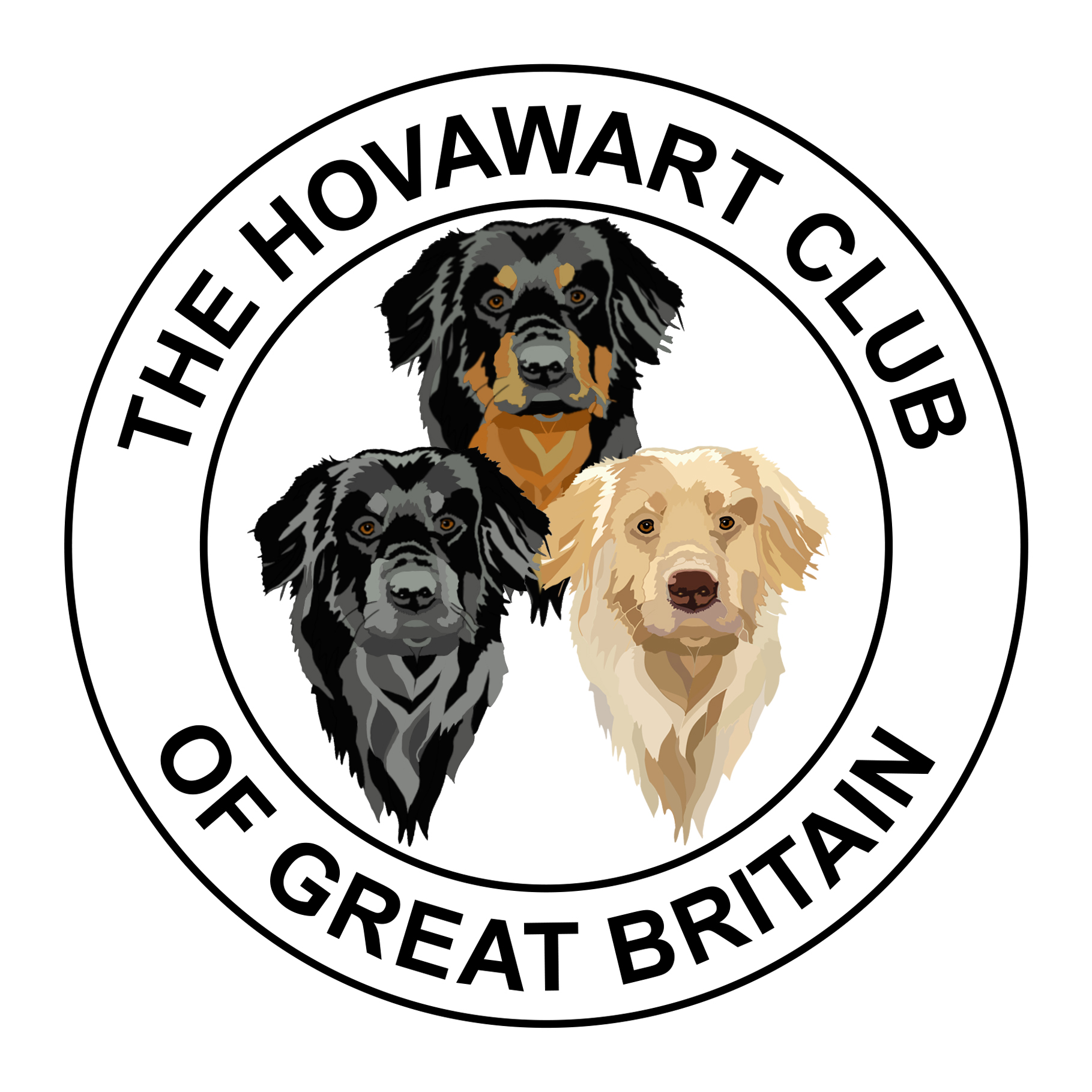Inspirational Hovawarts
Medical Detection - Kyra

Guide dog - Dinka
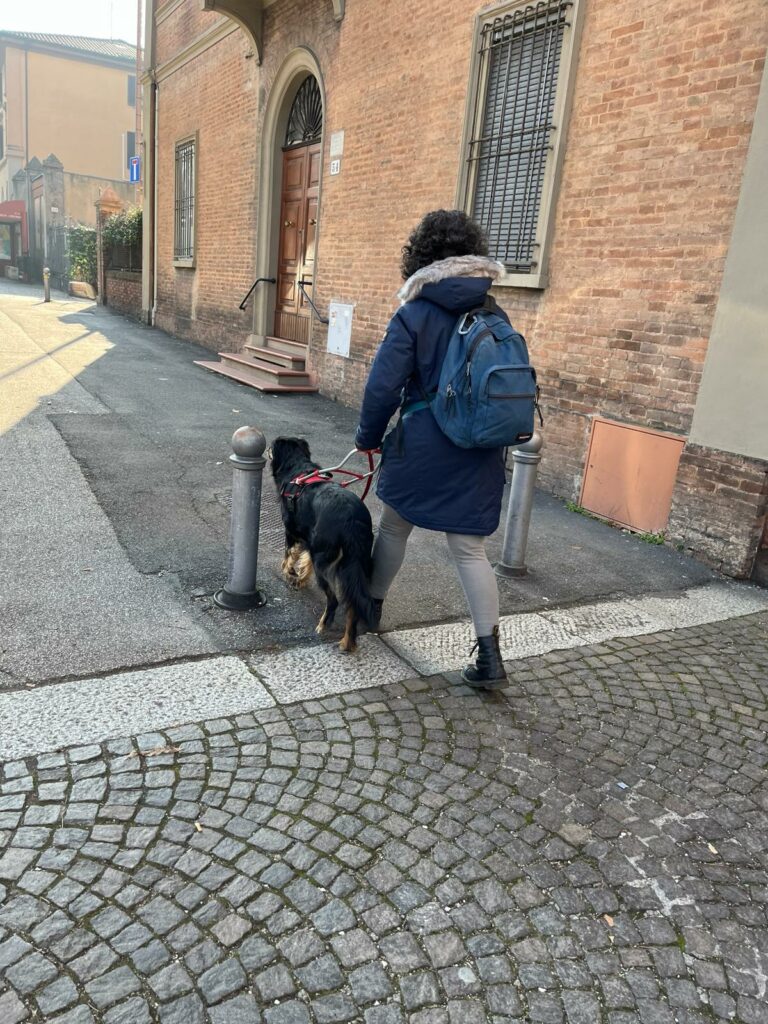
Assistance dog - Lucca
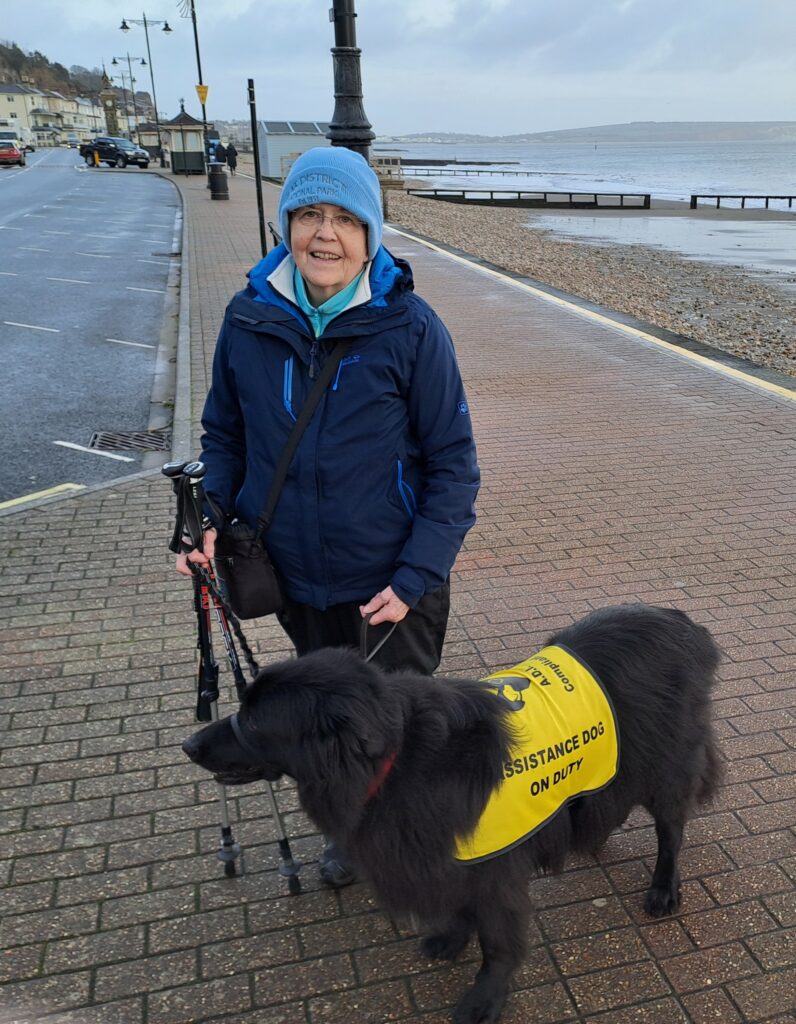
Find out why we are Inspirational below
Medical Detection Dog - Kyra
Medical Detection Dogs (MDD) trains dogs to save lives using their amazing sense of smell. This work will lead to faster, more accurate and less invasive diagnosis of disease and ultimately, better patient outcomes. The charity trains two different types of dogs:
Bio Detection Dogs are trained to find the odour of a disease in a human sample such as urine, breath or sweat in the charity’s training centre. These dogs are at the forefront of research into the fight against diseases like Cancer, Parkinson’s, Malaria and bacterial infections. This pioneering work is focused on researching and understanding how dogs could expand the world of diagnosis through the recognition of volatiles. What a dogs’ nose knows, will be able to help scientists and medics develop faster and cheaper ways to detect diseases much earlier than is currently possible.
Medical Alert Assistance Dogs are trained to detect minute changes in the odour of an individual with a complex, life-threatening health condition and alert them to an impending medical emergency so they can take the necessary action and avoid injury and hospitalisation. These dogs can help people with conditions such as PoTS Syndrome, Addison’s Disease and severe allergies and who have no prior warning that they are about to become seriously unwell. As well as saving their life on a daily basis, these dogs also restore independence and quality of life.
Kyra Update - 18 months old
Kyra is such a laidback, affectionate girl who is much adored by everyone here at Medical Detection Dogs. She lives with extremely dedicated fosterers who really enjoy having Kyra at home and put in a lot of time and effort with her training.
Kyra loves coming into the Centre as that means seeing all her favourite people, fun training sessions and often a groom which she particularly enjoys. All of her trainers have put in lots of work to making sure Kyra is comfortable with having baths, being blow-dried and having her feet and ears trimmed as this is something she will need regularly. She is so at ease being groomed now and it has all been worth it. Her fosterers have been helping her practice having her feet handled; she has been doing so well with this and she is now happy to stand patiently to have her nails clipped.
Click here to read the full story and see pictures of her adventures.

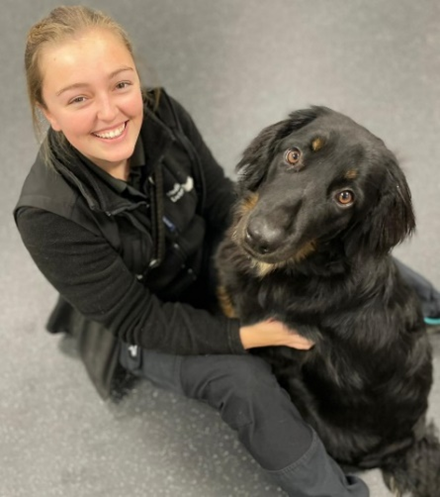
In July 2022, Kyra, a Hovawart, was very kindly donated to Medical Detection Dogs to join our Bio Detection dog team. Hovawarts are known for their good work ethic, are very versatile, and have proven to have a very good use of nose in other areas of scent work such as in working trials, therefore we were very excited to have our first Hovawart join us at MDD. We believe she may be the first of her breed to be used for Medical Detection work so she is a very special girl!
Kyra lives with a volunteer foster family who care for her day-to-day and love her as part of their family. MDD is proud to have a strict no-kennel policy and all the charity’s dogs live in family homes. Kyra is very lucky to have found a family who already have an older Hovawart, Nelson, to keep her company. Kyra is very settled at home and loves going for nice walks in the fields behind her home.
Kyra is supported by our Bio Detection Support Trainer, Katie. Katie meets with Kyra’s foster family weekly to give them support on general training matters such as home behaviour, general obedience, loose-lead walking and recall. She also attends fortnightly training classes with other Bio Detection puppies in training, a good place to learn about obedience, starting some scent work and the distractions of other people and dogs. Another important aspect of Kyra’s training so far is socialisation and confidence building; Katie has been taking Kyra out to various environments, meeting dogs, other animals, hearing sounds etc to help her grow into a confident, well socialised girl.
Since Kyra has turned 6 months, she has started going to MDD’s Training Centre weekly to start working towards her ‘Early Scent Training.’ During this phase she has been coming into the Bio Detection training room and getting used to the environment so she is relaxed and comfortable to start training. She has been meeting the Bio Detection trainers, playing games and having tasty treats! During this phase she has also started some scent training and is encouraged to find a piece of Kong toy hidden around the room, or hidden on the charity’s new ‘scent wall’ or under pots on the floor. Kyra is learning to use her nose, find the Kong odour and then she gets a fun game or a tasty reward – its all a big game to her! Her Foster Family drop her off and collect her, just like doing the school run – and Kyra is always really keen to come in and see everyone!
Katie, Kyra’s trainer, says “Kyra is developing into a wonderful girl, she loves nothing more than playing with her dog friends or enjoying a yummy chew at the pub with her fosterer (all part of the training of course)! She’s a favourite among the trainers and loves a cuddle after a successful session and is currently working towards her Early Scent Training programme. Kyra is starting to build her indication and finding the scent of Kong as her training odour. Outside of her Bio work, she is getting comfortable being in public areas and working on her lead walking around dogs. We’re all very pleased with how she is progressing and shows great potential for the future!”
Kyra is still very young and has lots of maturing to do, but over the next few months she will continue to progress her training. She will work towards her Early Scent Training Assessment and, if successful, will then be allocated onto a Bio Detection Project where she will then be trained to identify the odour of a particular Disease. It generally takes 6-8 months to train a Bio Detection Dog but this can vary dependent on a number of things such as the odour they are being trained to detect, the sample type they are using, and the dog itself (all dogs learn at different speeds). They generally love coming into work as they view it as a great game! They don’t tend to work longer than 20 minutes at a time, so there is plenty of work for rest and playtime too.
Medical Detection Dogs is very excited to have our first Hovawart in training as a Bio Detection Dog and looks forward to watching how she develops over the next few months.
If you would like more information on MDD have a sniff around the charity’s website https://www.medicaldetectiondogs.org.uk/ or contact [email protected]
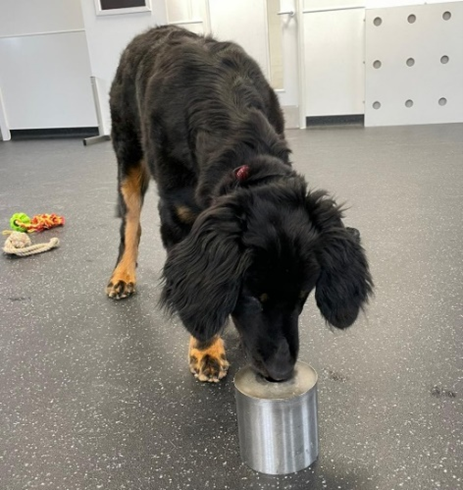
Guide dog - Dinka
The first thing I did with my new puppy was put on her a collar with a little bell. Along with the waterproof slippers I used to wear at home, that bell saved me and my house during my puppy’s childhood. Because I am a totally blind woman and live all by myself with my dog. The bell sound gives me an idea of where she is and what she is doing, and the slippers kept my feet dry and clean upon the discovery of another one of those little pools small puppies make all the time. My puppy is called Dinka, she is a black and tan hovawart. She is now four years old and has been the first of her breed being certified in Italy as a guide dog for blinds. I consider her my life’s masterpiece, because I trained her on my own: I am not a dog trainer, I am just someone who finds easy and rewarding to communicate with dogs and who, having had beforehand two guide dogs coming from an official school, knew what to ask the dog for.
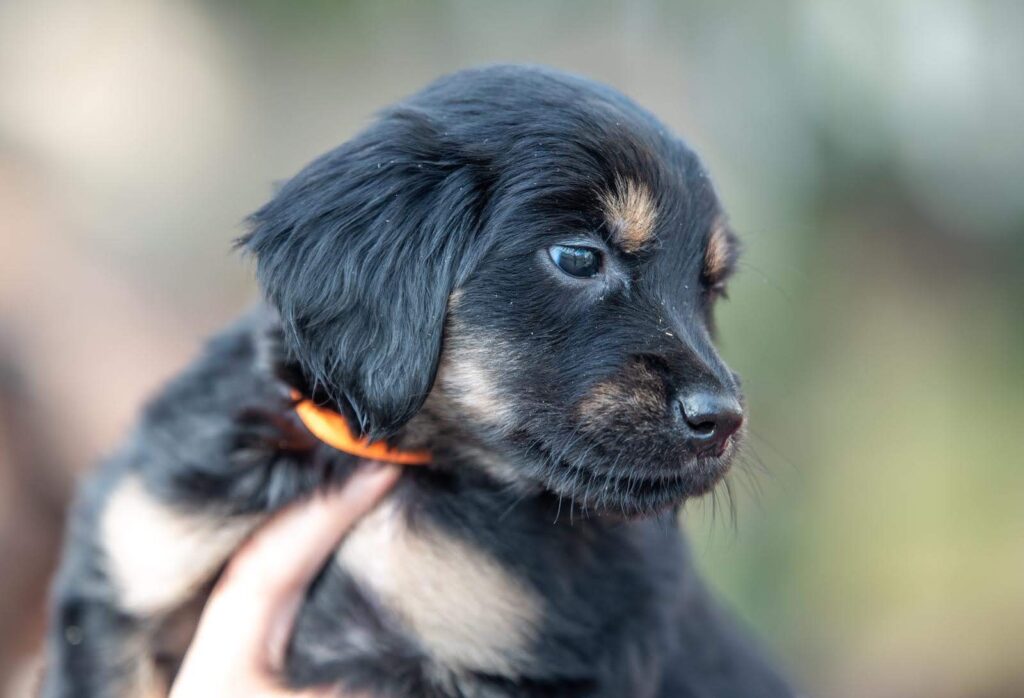
Our adventure started straight away after her arrival, because puppies need to go out a lot, for their frequent needs and because it’s important they see the world at this age. I walked with the dog on my left, the leash crossing in front of my belly and the leash’s handle around my right wrist, leaving my right hand free to use my white cane and my left hand free to quickly check on the puppy. When she stopped, I touched her and could tell by the position of her head that she was sniffing, or by the position and shape of her back that she was doing her business and even of which category. When I knew there was going to be something to collect, I placed my left foot besides her right hind paw, because I knew she was going to move when she was done and I needed to mark the place, this way I put one plastic bag on my hand and had only a small area to search.
I took her along with me everywhere, so that she had as many experiences as possible and got used to all the normal situations of a city living. In her first weeks with me, she was afraid of a number of things, like crossing doorways, going up or down staircases or crossing in front of gates behind which adult dogs barked. In those circumstances I never forced her to go ahead, but I never allowed her to retreat either, so we spent quarters of hour right before a garden gate or in front of a shop’s door and I think I made her have a meal on every step of our building’s stairs.
I used the time at home to teach her basic obedience and especially to play a lot with her. We like to fight, I bought a sleeve so that she can bite with satisfaction and I love the fact that we share such a physically intimate game. I made her go through a series of puzzle games of increasing difficulty in which she had for example to lift lids, pull ropes or open boxes to get her treats. I taught her to retrieve the ball, which is a great game for a blind person to play with their dog, because while the dog is pursuing the ball, we know what he or she is doing and is easily under control even if unleashed. Later this game upgraded to the useful thing that is she can retrieve for me objects that I have dropped. Later on, it upgraded again to her finding various things for me, like the public garbage bin, the traffic light or a door.
Very soon I made her catch the bus and the train, and few months later the plane too. Every walk we took was a chance for her to start getting familiar with the requests a guide dog needs to understand. Even though I knew she was too young to undergo a formal training, I thought it would not damage to start pointing her the way. So, every time we got to a corner I used to say “turn left” or “turn right” just before actually turning. Getting to the edge of the sidewalk I stopped, hit my feet on the ground to call her attention and said “curb”, after waiting for the right moment to cross the road I said “let’s cross, search the curb” and when getting to the other sidewalk I hit again my feet on the ground, said “curb” and showed great joy about it all. In the meanwhile I was walking her already with a leash length that caused her to start staying and getting used to the position of the guide dog, with its hind legs beside my own leg, and was showing her that she should keep the direction and the speed, by changing direction myself or stopping anytime she pulled. In fact, when she was eleven months old and I bought the guiding harness, she guided me the first day I put it on her. Because she only needed to keep doing the same things, I had always asked her to do. The harness changed my life, not hers, because to me it is the chance to feel very accurately, by means of the rigid handle, all the movements of my dog’s body, telling me she is stopping, turning left or right, going up or down and even how high the step is.
Now that we had the harness it was time to start working on her ability to avoid obstacles. Whenever she didn’t leave enough space between her body and the obstacle on our right so that I could pass through as well, I acted a dramatic scene of having hurt myself against that wicked obstacle that I was hitting loudly with my white cane. Then we turned back a few meters and repeated the incriminated passage. This time she naturally tended to stay as clearer as possible from the thing that seemed to cause so much fuss and I rewarded her a lot.
After working seriously on all these aspects for some weeks more we could finally see, after the pandemic, the guide dog instructor that came to our city, spent three days running after us to assess our proficiency and left saying that the dog was ready. From that day I knew that I could trust Dinka and stopped using the white cane on my right hand. The kind of sense of gratification I felt then can only be understood by those who know me well and knew how important it was for me. Not only now I have a guide dog that solves my problems but also, whenever Dinka is guiding me and doing a good job, I have to ask myself “was it really me who trained alone this great dog” and my heart nearly bursts out of pride and happiness.
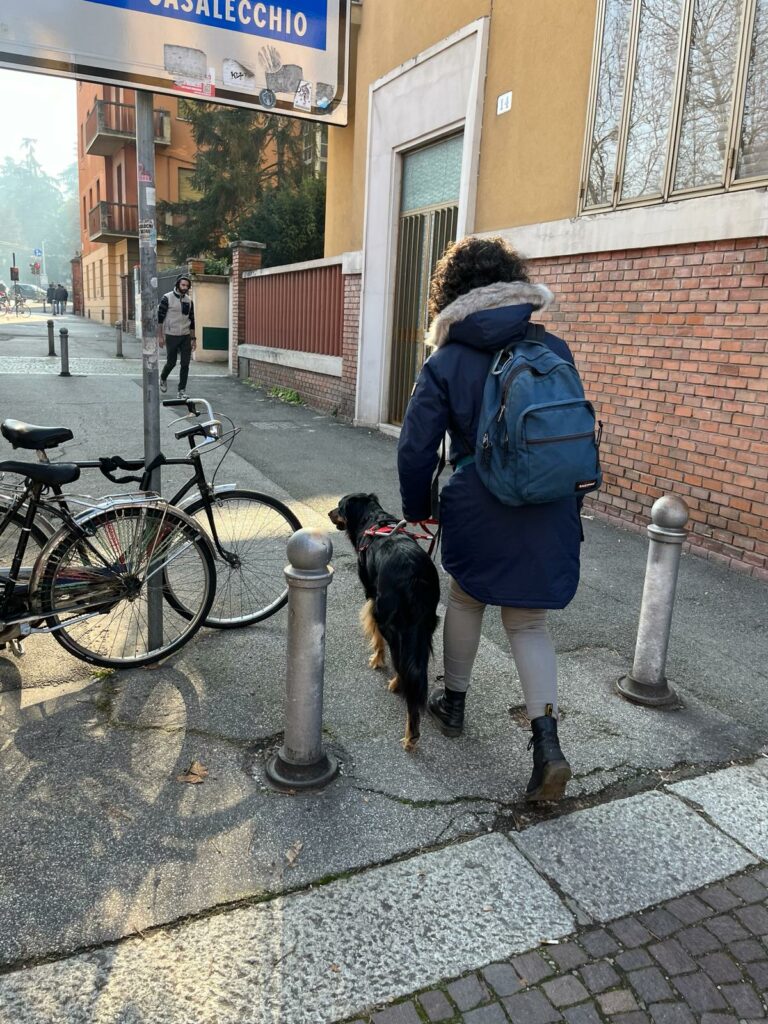
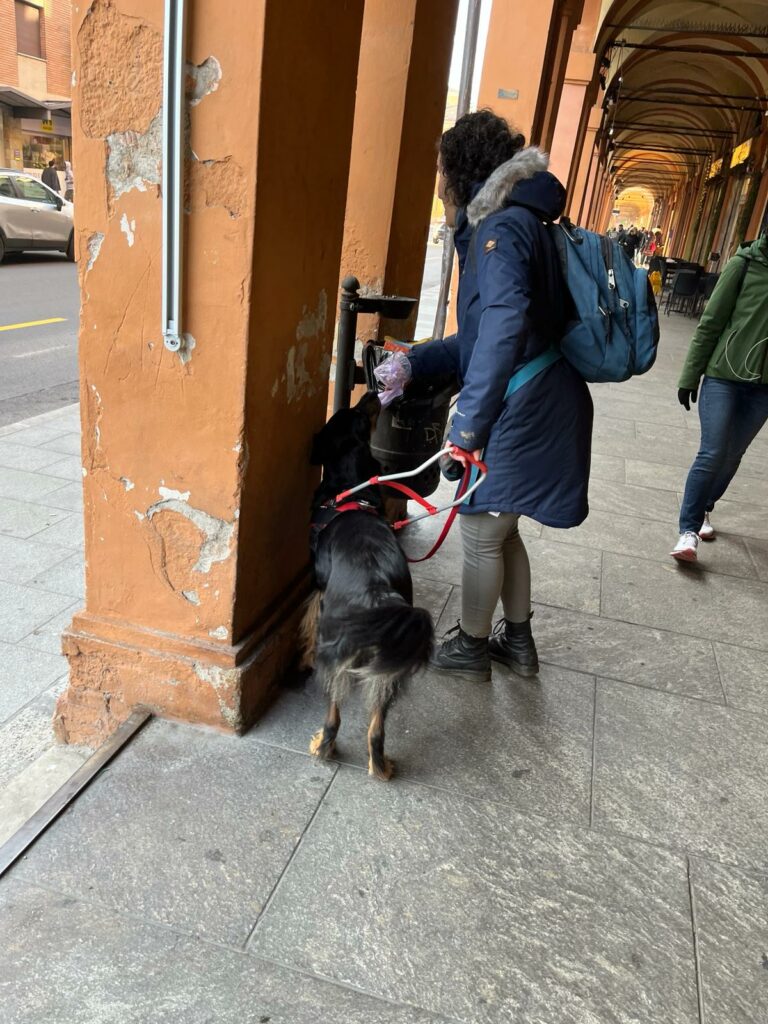
It has the sweet taste of those things that were hard to conquer. Let me say, just among us, who all love Hovawarts, and while nobody else is listening, I found my hovawart a very challenging dog. There was a moment I thought she was not intelligent, when after doing things the right way for a number of times, she went and failed next time, until I realize that she simply was finding more interesting to do something else. There was a moment I was concerned her courage and sense of protection would come in the way and would make it too complicated to manage, considering that as a guide dog she is being exposed to so many situations that many dogs don’t have to deal with. For her whole three first years I knew that she found me nice, but she was so independent and self-sufficient that she made me miss that deep bond that there can be between a person and a dog, and which is my primary reason for even wanting a dog in my life.
She gave me, and still does, the sensation of having invested a lot in her, that she required so much from me, my time, my attention, my patience, my determination, my efforts, in a word. But now I am enjoying a dog who is literally in love with me and who is so generous that’s accepting to do a lot of things that were totally out of her priorities list in the name of that love. Now we are truly a team, a strong one, I dare to say, and I feel that, with Dinka by my side, I am not vulnerable, I can go anywhere and do anything.
Assistance Dog - Lucca
We are so proud of our amazing boy, now 7 and a half.
About 18 months ago Ivor had gone to watch football over in Portsmouth. Background information, I have severe Scoliosis, severe arthritis of spine hips knees etc.
While Ivor was out I was looking for a pair of shoes underneath the bed and got stuck. I called Lucca and told him to stand and brace – I managed to get myself up. Lucca has never heard the word brace before.
This set me thinking, that he could be incredibly helpful to me with my increasing disabilities.
I did a huge amount of research as to how he could be trained to be my registered Assistance dog.
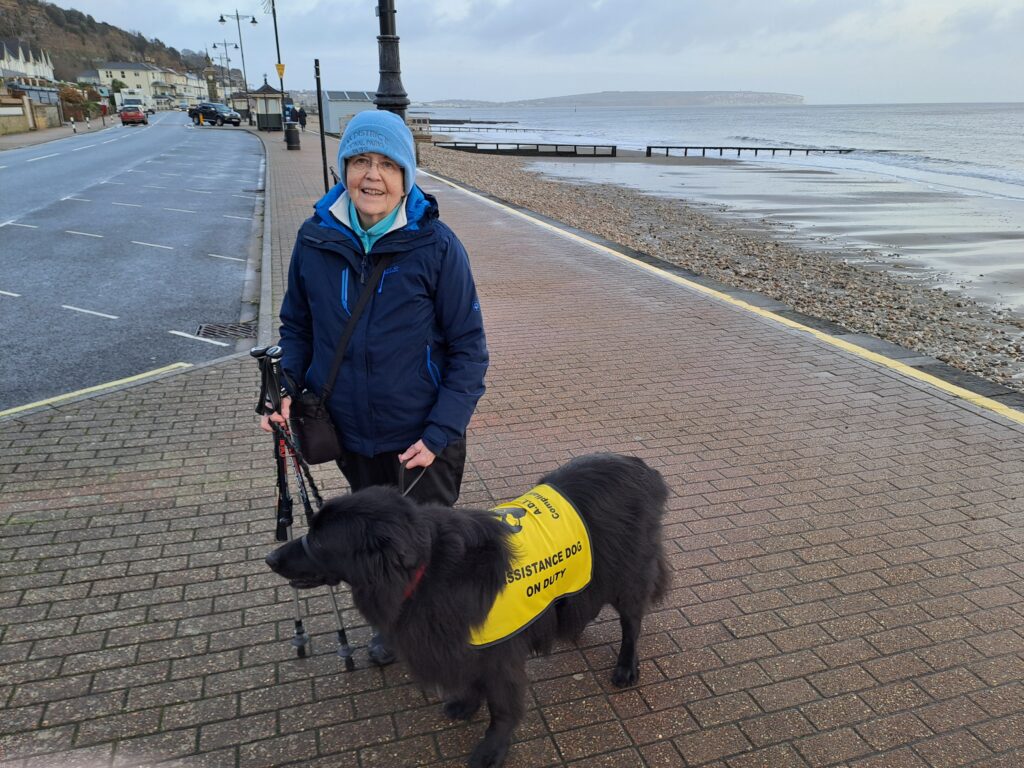
Canine Partners were not taking any new trainees, however I found The Service Dog Training School International, a private school who will train you with your own dog. Based in America with branches in Dublin and the Far East, we embarked on 120 hours training. I had a designated tutor for support, written work was online, with Ivor as cameraman filming the tasks which were then sent to the tutor. Extremely intensive with 8 modules. It was a huge undertaking but after 6 months Lucca passed with flying colours. He is now ADI Compliance registered.
His training from puppy onwards – we always do training tasks daily stood him in good stead.
He is now very well known on the island. With his smart yellow vest – made by Colan who make the Guide dog puppies’ vests. He is welcomed when I see the Orthopaedic consultant every 6 weeks, giving so much pleasure to nurses and doctors and of course other patients. He is also welcomed in shops, and many cafes where the occasional sausage may appear.
